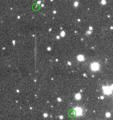Eurydome (moon) facts for kids
Eurydome, also called Jupiter XXXII, is one of the many moons that orbit the giant planet Jupiter. It was discovered in 2001 by a team of astronomers. This team was from the University of Hawaii and was led by Scott S. Sheppard. When it was first found, it was given the temporary name S/2001 J 4.
Eurydome is quite small, only about 3 kilometres wide. It travels around Jupiter very far away, about 23,231,000 kilometres from the planet. One full trip around Jupiter takes Eurydome about 723 days. Its path around Jupiter is tilted quite a bit, about 149 degrees compared to the ecliptic (the path the Sun seems to take across our sky).
Naming Eurydome
This moon got its official name in August 2003. It was named after a character from Greek mythology called Eurydome. In these ancient stories, Eurydome is sometimes said to be the mother of the Graces. The Graces were goddesses of charm, beauty, nature, human creativity, and fertility. She had these children with Zeus, who is the king of the gods in Greek mythology. Zeus is also known as Jupiter in Roman mythology, which is why the planet is named after him.
The Pasiphaë Group
Eurydome is part of a family of moons known as the Pasiphaë group. This group includes several moons that share similar orbits around Jupiter. These moons are not round like Earth's Moon; they have irregular, lumpy shapes. They also orbit Jupiter in a special way called "retrograde." This means they orbit in the opposite direction compared to Jupiter's rotation. Moons in the Pasiphaë group orbit Jupiter at distances between 22,800,000 and 24,100,000 kilometres. Their orbits are also very tilted, ranging from 144.5 to 158.3 degrees.
Images for kids
-
This image shows both Hermippe and Eurydome. It was taken by the CFHT in December 2001, when they were first discovered.
See also
 In Spanish: Eurídome (satélite) para niños
In Spanish: Eurídome (satélite) para niños


